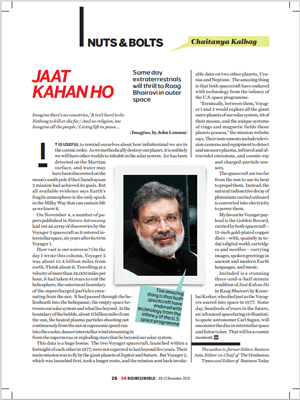Jaat Kahan Ho
[Business World]
Published date: 9th Nov 2019
It is Useful to remind ourselves about how infinitesimal we are in the cosmic order. As we methodically destroy our planet, it is unlikely we will have other worlds to inhabit in the solar system. Ice has been detected on the Martian surface, and water may have been discovered on the moon’s south pole if the Chandrayaan 2 mission had achieved its goals. But all available evidence says Earth’s fragile atmosphere is the only speck in the Milky Way that can sustain life as we know it.
On November 4, a number of papers published in Nature Astronomy laid out an array of discoveries by the Voyager 2 spacecraft as it entered interstellar space, six years after its twin Voyager 1.
How vast is our universe? On the day I wrote this column, Voyager 2 was about 13.4 billion miles from earth. Think about it. Travelling at a velocity of more than 34,000 miles per hour, it had taken 41 years to exit the heliosphere, the outermost boundary of the supercharged particles emanating from the sun. It had passed through the heliosheath into the heliopause, the empty space between our solar system and what lies beyond. At the boundary of the bubble, about 11 billion miles from the sun, the heated plasma particles shooting out continuously from the sun at supersonic speed run into the cooler, denser interstellar wind streaming in from the supernovas or exploding stars that lie beyond our solar system.
This data is a huge bonus. The two Voyager spacecraft, launched within a fortnight of each other in 1977, were not expected to last beyond five years. Their main mission was to fly by the giant planets of Jupiter and Saturn. But Voyager 2, which was launched first, took a longer route, and the mission sent back invaluable data on two other planets, Uranus and Neptune. The amazing thing is that both spacecraft have endured with technology from the infancy of the U.S. space programme.
“Eventually, between them, Voyager 1 and 2 would explore all the giant outer planets of our solar system, 48 of their moons, and the unique systems of rings and magnetic fields those planets possess,” the mission website says. Their instruments include television cameras and equipment to detect and measure plasma, infrared and ultraviolet emissions, and cosmic-ray and charged-particle sensors.
The spacecraft are too far from the sun to use its heat to propel them. Instead, the natural radioactive decay of plutonium carried onboard is converted into electricity to power them.
My favourite Voyager pay- load is the Golden Record, carried by both spacecraft – 12 inch gold-plated copper discs – with, quaintly in today’s digital world, cartridges and needles − carrying images, spoken greetings in ancient and modern Earth languages, and music.
Included is a stunning three-and-a-half minute rendition of Jaat Kahan Ho in Raag Bhairavi by Kesarbai Kerkar, who died just as the Voyagers soared into space in 1977. Some day, hundreds of years in the future, an ‘advanced spacefaring civilisation’, to quote astronomer Carl Sagan, will encounter the disc in interstellar space and listen to her. That will be a cosmic moment.






